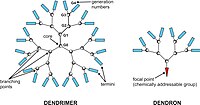
Photo from wikipedia
A MUC1 anticancer vaccine equipped with covalently linked divalent mannose ligands was found to improve the antigen uptake and presentation by targeting mannose‐receptor‐positive macrophages and dendritic cells. It induced much… Click to show full abstract
A MUC1 anticancer vaccine equipped with covalently linked divalent mannose ligands was found to improve the antigen uptake and presentation by targeting mannose‐receptor‐positive macrophages and dendritic cells. It induced much stronger specific IgG immune responses in mice than the non‐mannosylated reference vaccine. Mannose coupling also led to increased numbers of macrophages, dendritic cells, and CD4+ T cells in the local lymph organs. Comparison of di‐ and tetravalent mannose ligands revealed an increased binding of the tetravalent version, suggesting that higher valency improves binding to the mannose receptor. The mannose‐coupled vaccine and the non‐mannosylated reference vaccine induced IgG antibodies that exhibited similar binding to human breast tumor cells.
Journal Title: ChemMedChem
Year Published: 2018
Link to full text (if available)
Share on Social Media: Sign Up to like & get
recommendations!